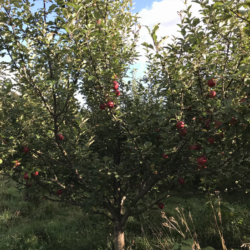Description
Key Features:
Size & Growth: Typically reaches a mature height of 12 to 15 feet with a spread of 10 to 12 feet. Its compact size makes it a perfect fit for smaller landscapes, gardens, and urban settings.
Foliage: The Adirondack Crabapple features dark green, glossy leaves that create a lush backdrop for its floral and fruit displays. In the fall, the foliage turns a vibrant yellow, providing additional seasonal color.
Flowers: In spring, this crabapple tree bursts into a profusion of striking, deep pink to red flowers. The blossoms are not only visually captivating but also attract pollinators like bees and butterflies, enhancing the biodiversity of your garden.
Fruit: The tree produces small, bright red to orange crabapples that appear in late summer to early fall. These ornamental fruits add a splash of color and can attract birds and wildlife. While they are generally too tart for human consumption, they can be used in homemade jams or preserves.
Disease Resistance: The Adirondack Crabapple is known for its impressive resistance to common crabapple diseases such as apple scab, fire blight, and cedar-apple rust. This resilience makes it a low-maintenance option for a variety of garden settings.
Soil & Light Requirements: Thrives in well-drained soil and prefers full sun to partial shade. It is adaptable to different soil types, including clay, loam, and sandy soils.
Care Instructions: Requires minimal maintenance beyond regular watering and occasional pruning to maintain its shape. Ensure to provide adequate water during dry periods, especially when the tree is young.
Uses:
Ornamental: Ideal for adding a splash of color and texture to garden beds, borders, or as a focal point in small to medium-sized landscapes.
Pollinator Garden: The vibrant flowers attract bees and butterflies, making it an excellent addition to pollinator-friendly gardens.
Wildlife: The small fruits provide a food source for birds and other wildlife, adding an ecological benefit to your garden.
Planting & Maintenance:
Planting: Best planted in a location that receives full sun to partial shade. Prepare a hole that is twice the width of the root ball and ensure good drainage to prevent root rot.
Watering: Keep the soil consistently moist during the first growing season to help the tree establish. Once established, it is relatively drought-tolerant but will benefit from supplemental watering during prolonged dry periods.
Pruning: Prune to remove any dead or crossing branches and to shape the tree as needed. Regular pruning can help maintain a tidy appearance and promote better air circulation.
Enhance your garden with the Adirondack Crabapple, a versatile and visually striking tree that offers stunning blossoms, attractive foliage, and colorful fruit. Its hardy nature and low-maintenance requirements make it a fantastic choice for creating a vibrant, year-round landscape.





